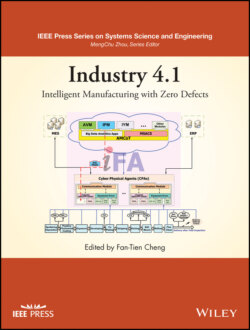Читать книгу Industry 4.1 - Группа авторов - Страница 62
Cross‐Correlation SFs
ОглавлениеGenerally, the Pearson product‐moment correlation coefficient [13] measures the similarity degree between two signals in the same time without any time lag. Given that x(t) and y(t) are two continuous‐time signals with time T, and their correlation coefficient value crxy, ranging from negative one to positive one, is defined in (2.7).
The cross‐correlation is similar to correlation coefficient, but it takes time lag into consideration. One signal is allowed to be time‐shifted and slide over the other to compare the similarity of two independent signals at each stride. It helps to find out where the two waveforms match the best at a certain time.
For random signals, the cross‐correlation CRxy between x(t) and y(t) is expressed in (2.8):
where γxy is the covariance expressed in (2.9):
Thus, cross‐correlation can be simplified by the ratio in (2.10):
For deterministic signals, the cross‐correlation of two continuous and periodic signals x(t) and y(t) can be defined by the integration from +∞ to −∞ as in (2.11), where notation * denotes the complex conjugate; x(t) is fixed and y(t) is shifted forward/backward by m, which is the displacement, or the so‐called lag.
For discrete signals x[n] and y[n] with length N, the cross‐correlation is defined as in (2.12), the products of two signals and the integration are replaced by any interval of period T at each point.
Cross‐correlation repeats to successively slide one signal along the x‐axis and compare with the other until the maximized correlation value is found. The reason is that two signals with the same sign (both positive or negative) tend to have a large correlation. Especially, when both peaks or troughs are aligned, it must be the best correlation. On the other hand, when signals have opposing signs at a certain time, its correlation or integral area must be small.
Cross‐correlation is very useful in the pattern recognition within a signal or between two signals. It is widely used to check the stability of sensor data and remove noise in a mass production environment. Note that, each CRxy can serve as a critical SF in a set, which can be expressed as SFCR(xy) = CRxy.
